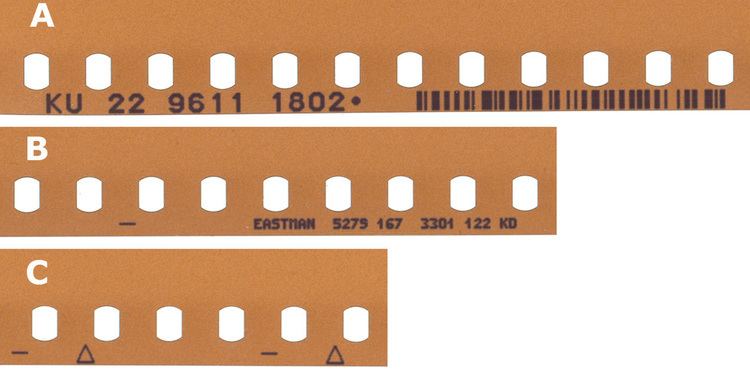 | ||
Keykode (also written as either KeyKode or KeyCode) is an Eastman Kodak Company advancement on edge numbers, which are letters, numbers and symbols placed at regular intervals along the edge of 35 mm and 16 mm film to allow for frame-by-frame specific identification. It was introduced in 1990.
Contents
Keykode is a variation of time code used in the post-production process which is designed to uniquely identify film frames in a film stock.
Edge numbers
Edge numbers (also called key numbers or footage numbers) are a series of numbers with key lettering printed along the edge of a 35 mm negative at intervals of one foot (16 frames or 64 perforations) and on a 16 mm negative at intervals of six inches (twenty frames). The numbers are placed on the negative at the time of manufacturing by one of two methods:
Latent image exposes the edge of the film while it passes through the perforation machine. This method is primarily utilized for color negative films.Visible ink is sometimes utilized to imprint on the edge of the film - again in manufacturing - at the time of perforations. The ink, which is not affected by photographic chemicals, is normally printed onto the base surface of the film. The numbers are visible on both the raw stock (unexposed) and processed (exposed and developed) film. This method is primarily utilized for black & white negative film.The edge numbers serve a number of purposes. Every key frame is numbered with a multi-digit identifier that may be referred to later. In addition, a date of manufacturing is imprinted, then the type of emulsion and the batch number. This information is transferred from the negative (visible once developed) to the positive prints. The print may be edited and handled while the original negative remains safely untouched. When the film editing is complete, the edge numbers on the final cut film correspond back to their identical frames on the original negative so that a conform edit can be made of the original negative to match the work print.
Laboratories can also imprint their own edge numbers on the processed film negative or print to identify the film for their own means. This is normally done in yellow ink. A common workflow for film editing involves edge-coding printed film simultaneously with the film's synchronized audio track, on 35mm magnetic film, so that a foot of film and its synchronized audio have identical edge numbers.
Keykode
With the popularity of telecine transfers and video edits, Kodak invented a machine readable edge number that could be recorded via computer, read by the editing computer and automatically produce a "cut list" from the video edit of the film.
To do this, Kodak utilized the USS-128 barcode alongside the human-readable edge numbers. They also improved the quality and readability of the human-readable information to make it easier to identify. The Keykode consists of 12 characters in human-readable form followed by the same information in barcode form. Keykode is a form of metadata identifier for film negatives.
Keykode deciphered
An example Keykode:
KU 22 9611 1802+02.3
E and K both stand for Kodak, F stands for Fuji, etc.) and the stock identifier, respectively (in this case Kodak's U standing for 5279 emulsion); each manufacturer has different stocks' naming convention for their emulsion codes.EASTMAN 5279 167 3301 122 KD
